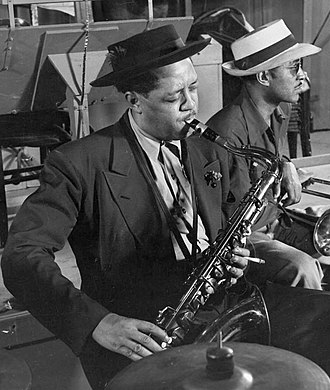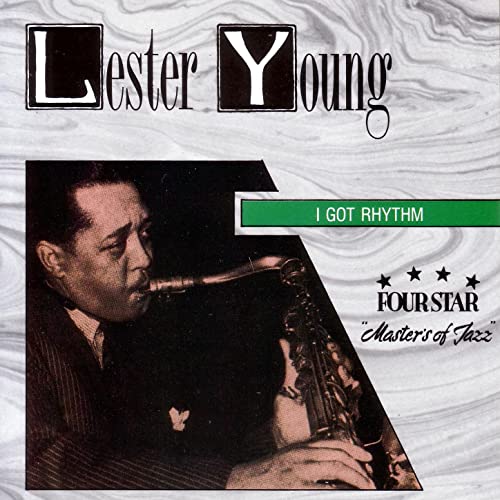
Young, Lester
Lester Willis Young (August 27, 1909 – March 15, 1959), nicknamed “Pres” or “Prez”, was an American jazz tenor saxophonist and occasional clarinetist.
Coming to prominence while a member of Count Basie’s orchestra, Young was one of the most influential players on his instrument. In contrast to many of his hard-driving peers, Young played with a relaxed, cool tone and used sophisticated harmonies, using what one critic called “a free-floating style, wheeling and diving like a gull, banking with low, funky riffs that pleased dancers and listeners alike”.
Known for his hip, introverted style, he invented or popularized much of the hipster jargon which came to be associated with the music.
In 1933, Young settled in Kansas City, where after playing briefly in several bands, he rose to prominence with Count Basie. His playing in the Basie band was characterized by a relaxed style which contrasted sharply with the more forceful approach of Coleman Hawkins, the dominant tenor sax player of the day. One of Young’s key influences was Frank Trumbauer, who came to prominence in the 1920s with Paul Whiteman and played the C-melody saxophone (between the alto and tenor in pitch).
Young left the Basie band to replace Hawkins in Fletcher Henderson‘s orchestra. He soon left Henderson to play in the Andy Kirk band (for six months) before returning to Basie. While with Basie, Young made small-group recordings for Milt Gabler‘s Commodore Records, The Kansas City Sessions. Although they were recorded in New York (in 1938, with a reunion in 1944), they are named after the group, the Kansas City Seven, and comprised Buck Clayton, Dicky Wells, Basie, Young, Freddie Green, Rodney Richardson, and Jo Jones. Young played clarinet as well as tenor in these sessions. Young is described as playing the clarinet in a “liquid, nervous style.”As well as the Kansas City Sessions, his clarinet work from 1938–39 is documented on recordings with Basie, Billie Holiday, Basie small groups, and the organist Glenn Hardman. Billie and Lester met at a Harlem jam session in the early 30s and worked together in the Count Basie band and in nightclubs on New York’s 52nd St. At one point Lester moved into the apartment Billie shared with her mother, Sadie Fagan. Holiday always insisted their relationship was strictly platonic. She gave Lester the nickname “Prez” after President Franklin Roosevelt, the “greatest man around” in Billie’s mind. Playing on her name, he would call her “Lady Day.” Their famously empathetic classic recordings with Teddy Wilson date from this era.
After Young’s clarinet was stolen in 1939, he abandoned the instrument until about 1957. That year Norman Granz gave him one and urged him to play it (with far different results at that stage in Young’s life—see below).
Young left the Basie band in late 1940. He is rumored to have refused to play with the band on Friday, December 13 of that year for superstitious reasons spurring his dismissal, although Young and drummer Jo Jones would later state that his departure had been in the works for months. He subsequently led a number of small groups that often included his brother, drummer Lee Young, for the next couple of years; live and broadcast recordings from this period exist.
During this period Young accompanied the singer Billie Holiday in a couple of studio sessions (during 1937 – 1941 period) and also made a small set of recordings with Nat “King” Cole (their first of several collaborations) in June 1942. His studio recordings are relatively sparse during the 1942 to 1943 period, largely due to the recording ban by the American Federation of Musicians. Small record labels not bound by union contracts continued to record and he recorded some sessions for Harry Lim’s Keynote label in 1943.
In December 1943, Young returned to the Basie fold for a 10-month stint, cut short by his being drafted into the army during World War II . Recordings made during this and subsequent periods suggest Young was beginning to make much greater use of a plastic reed, which tended to give his playing a somewhat heavier, breathier tone (although still quite smooth compared to that of many other players). While he never abandoned the cane reed, he used the plastic reed a significant share of the time from 1943 until the end of his life. Another cause for the thickening of his tone around this time was a change in saxophone mouthpiece from a metal Otto Link to an ebonite Brilhart. In August 1944, Young appeared alongside drummer Jo Jones, trumpeter Harry “Sweets” Edison, and fellow tenor saxophonist Illinois Jacquet in Gjon Mili‘s short film Jammin’ the Blues.
Young’s career after World War II was far more prolific and lucrative than in the pre-war years in terms of recordings made, live performances, and annual income. Young joined Norman Granz‘s Jazz at the Philharmonic troupe in 1946, touring regularly with JATP over the next 12 years. He made many studio recordings under Granz’s supervision as well, including more trio recordings with Nat King Cole. Young also recorded extensively in the late 1940s for Aladdin Records (1946-1947, where he had made the Cole recordings in 1942) and for Savoy (1944, 1949 and 1950), some sessions of which included Basie on piano.
While the quality and consistency of his playing ebbed gradually in the latter half of the 1940s and into the early 1950s, he also gave some brilliant performances during this stretch. Especially noteworthy are his performances with JATP in 1946, 1949, and 1950.[citation needed] With Young at the 1949 JATP concert at Carnegie Hall were Charlie Parker and Roy Eldridge, and Young’s solo on “Lester Leaps In” at that concert is a particular standout among his performances in the latter half of his career.
From around 1951, Young’s level of playing declined more precipitously as his drinking increased. His playing showed reliance on a small number of clichéd phrases and reduced creativity and originality, despite his claims that he did not want to be a “repeater pencil” (Young coined this phrase to describe the act of repeating one’s own past ideas). Young’s playing and health went into a crisis, culminating in a November 1955 hospital admission following a nervous breakdown.
He emerged from this treatment improved. In January 1956, he recorded two Granz-produced sessions including a reunion with pianist Teddy Wilson, trumpet player Roy Eldridge, trombonist Vic Dickenson, bassist Gene Ramey, and drummer Jo Jones – which were issued as The Jazz Giants ’56 and Pres and Teddy albums. 1956 was a relatively good year for Lester Young, including a tour of Europe with Miles Davis and the Modern Jazz Quartet and a successful residency at Olivia Davis’ Patio Lounge in Washington, DC, with the Bill Potts Trio. Live recording of Young and Potts in Washington were issued later.
Throughout the 1940s and 50s, Young occasionally played as a featured guest with the Count Basie Orchestra. The best-known of these appearances is the July 1957 performance at the Newport Jazz Festival, with a line-up including many of his 1940s colleagues: Jo Jones, Roy Eldridge, Illinois Jacquet and Jimmy Rushing. In 1952 he was featured on Lester Young with the Oscar Peterson Trio, released in 1954 on Norgran.[17] In 1956, he recorded two LPs with his 1930s collaborators Teddy Wilson and Jo Jones. Allmusic’s Scott Yanow, reviewing one of the albums, Pres and Teddy, commented:
Although it has been written much too often that Lester Young declined rapidly from the mid-’40s on, the truth is that when he was healthy, Young played at his very best during the ’50s, adding an emotional intensity to his sound that had not been present during the more carefree days of the ’30s. This classic session finds the great tenor in particularly expressive form.
On December 8, 1957, Young appeared with Billie Holiday, Coleman Hawkins, Ben Webster, Roy Eldridge, and Gerry Mulligan in the CBS television special The Sound of Jazz, performing Holiday’s tune “Fine and Mellow.” It was a reunion with Holiday, with whom he had lost contact over the years. She was also in physical decline, near the end of her career, yet they both gave moving performances. Young’s solo was brilliant, acclaimed by some observers as an unparalleled marvel of economy, phrasing and extraordinarily moving emotion; Nat Hentoff, one of the show’s producers, later commented, “Lester got up, and he played the purest blues I have ever heard…in the control room we were all crying.”
Young made his final studio recordings and live performances in Paris in March 1959 with drummer Kenny Clarke at the tail end of an abbreviated European tour during which he ate next to nothing and drank heavily. On a flight to New York City, he suffered from internal bleeding due to the effects of alcoholism and died in the early morning hours of March 15, 1959, only hours after arriving back in New York, at the age of 49.
According to jazz critic Leonard Feather, who rode with Holiday in a taxi to Young’s funeral, she said after the services, “I’ll be the next one to go.” Holiday died four months later on July 17, 1959 at age 44.
Lester Young is said to have popularized use of the term “cool” to mean something fashionable. Another slang term he coined was the term “bread” for money. He would ask, “How does the bread smell?” when asking how much a gig was going to pay.
